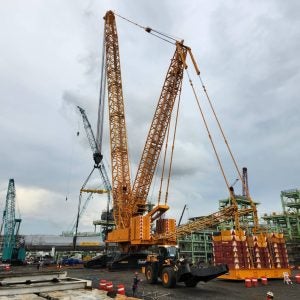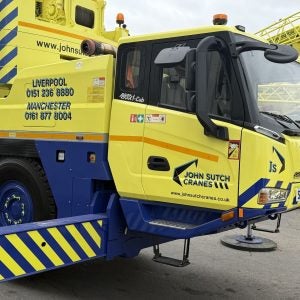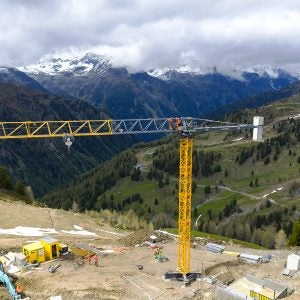The new Rhine bridge, which has been under construction since 2005, is one of three construction phases for the Wesel by-pass on the B 58n. After completion in 2008, this 772.5-metres long cable-stayed bridge will have four traffic lanes, together with two cycle tracks and a central reservation. This type of bridge was chosen to meet the need for an unsupported span of at least 300 metres wide for shipping on the Rhine. The supporting structure is divided into a pre-stressed concrete foreland bridge 376 metres long on the left bank of the Rhine and a 396-metre steel-construction river bridge. What grabs the attention, and can be seen from a long way off, is the 130-metre high-strength concrete bridge pylon in the shape of an inverted letter Y on the left bank of the Rhine.
A Liebherr 280 EC-H 16 Litronic tower crane providing a maximum working radius of 70 m was erected for the construction of the pylon. The tower crane, which comprises the 500 HC tower system mounted on foundation anchor bolts, reaches a maximum under-hook height of 142.4 m. Due to the dimensioning of the 500 HC tower system, this huge under-hook height can be achieved with only one anchorage on the pylon. With a maximum load capacity of 3,100 kg at jib end, the tower crane demonstrated a great capacity for handling materials, even when lifting the heaviest formwork units and during the concreting work.
As construction on the slip-formed reinforced-concrete pier progressed, the 280 EC-H 16 Litronic first of all rose to a height of 90 metres. Then the Liebherr LG 1750-type lattice boom mobile crane placed six enormous steel ingots, each 15-metres high and weighing 75 t, on top. This increased the height of the pylon by a further 45 m. During this process, the steel workers radioed instructions about the centimetre-perfect positioning of the massive steel units from the top of the pylon until had they arrived in their intended position and could be welded. The function of the steel blocks is to accommodate a total of 72 bridge cables, each with a diameter of 115 millimetres. These cables are then anchored to both the foreland bridge and the river bridge. The steel core distributes the cable forces of the cable-stayed bridge.
The LG 1750 had finished the job in a little over a day, considerably faster than planned, once all the steel cores of the bridge pier, which can be seen from a long way off, were assembled. Previously, the mobile crane had also been erected just as rapidly. After only one and half days’ set-up time, the crane, with its 56-metre main mast and 70-metre luffing jib, was ready for use. Because of the LG 1750’s large supporting area of 16 m by 16 m and the slewing platform extension used, which increases the ballast radius by 2.65 metres, a total of only 150 tonnes of ballast was needed to erect the mast.
A lattice-boom mobile crane helps build a pylon on a new bridge in Wesel, Germany A lattice-boom mobile crane helps build a pylon on a new bridge in Wesel, Germany






